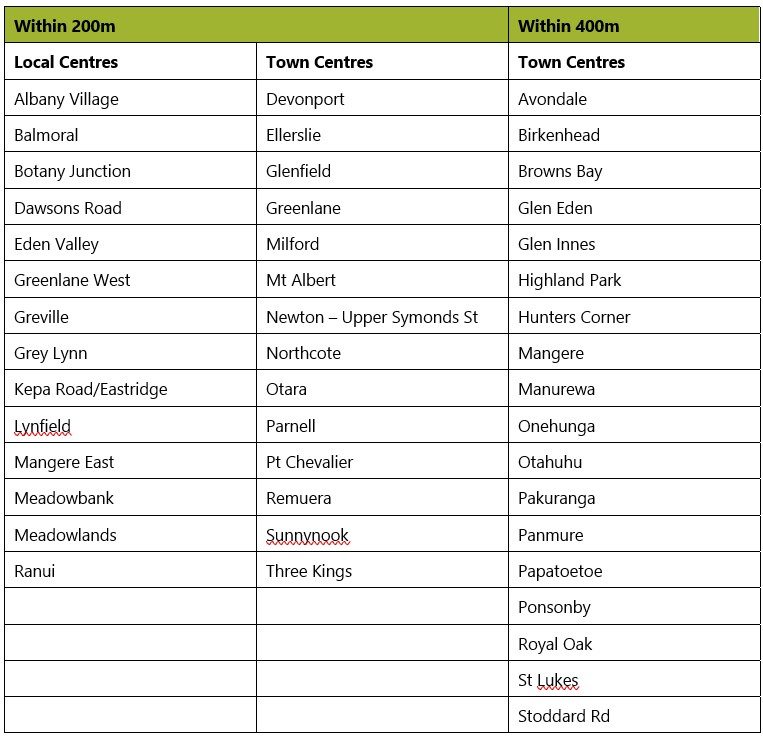NPS-UD: Updated Principles for Intensification
By Iain McManus
Auckland Council’s Planning Committee has approved a new set of principles for addressing part of the National Policy Statement on Urban Development (“NPS-UD”).
This is in response to the RMA Amendment Act 2021 which (amongst other things) has introduced a set of “Medium Density Residential Standards” (“MDRS”) and replaced policy 3(d) of the NPS-UD.
The MDRS are discussed in my previous blogs – see here, here and here – and will enable widespread intensification. This has allowed the focus of policy 3(d) to be narrowed under the Amendment Act.
Changes to the NPS-UD
The original NPS-UD required councils to enable a certain level of development within all City Centre and Metropolitan Centre zones and within a walkable catchment of those zones and rapid transit stops in accordance with policies 3(a) to 3(c) of the NPS.
It then required councils to enable intensification in “all other locations” in accordance with policy 3(d) of the NPS. This required plans to enable:
(d) in all other locations…, building height and density of urban form commensurate with the greater of:
(i) the level of accessibility by existing or planned active or public transport to a range of commercial activities and community services; or
(ii) relative demand for housing and business use in that location.
The RMA Amendment Act 2021 has replaced policy 3(d) of the NPS with a new policy focused on land within and adjacent to the Neighbourhood Centre, Local Centre and Town Centre zones. The new policy reads as follows:
(d) within and adjacent to neighbourhood centre zones, local centre zones, and town centre zones (or equivalent), building heights and density of urban form commensurate with the level of commercial activity and community services.
Implications for Auckland
The original policy 3(d) would have required extensive up-zoning within the central isthmus area due to the high accessibility and relative demand (measured by land value) of that area and within the coastal parts of the lower North Shore due to the high relative demand for land in those areas.
The new policy 3(d) allows Council to focus its analysis (under that policy) on land within and around small to mid-size centres, although Council will need to look beyond the central isthmus and North Shore in doing so.
Auckland Council’s Principles
In its meeting on 3 March 2022, Auckland Council’s Planning Committee confirmed the following principles for application of the new policy:
1. No change to building height or density of form permitted within or adjacent to any Neighbourhood Centres (as these are typically very small centres and therefore do not have a level of commercial activity or community services that warrants intensification beyond that already permitted within the zone or to be permitted within the surrounding area under the MDRS).
2. No change to building height or density of form permitted within or adjacent to any Local Centres that are small in size or have low accessibility (as Council considers the Local Centre zone already provides for building height and density of form commensurate with the level of commercial activity and community services in each such centre, and the MDRS will do the same for the surrounding areas).
3. No change to building height or density of form permitted within or adjacent to any Town Centres that have low accessibility (as Council considers the Town Centre zone already provides for building height and density of form commensurate with the level of commercial activity and community services in each such centre, and the MDRS will do the same for the surrounding areas).
4. Apply the Terrace Housing and Apartment Buildings zone to residential areas adjacent to the edge of the following zones (up to approx. 200m from the edge):
Local Centres that are both large in size and have high accessibility;
Town Centres that are small in size but have high accessibility.
5. Apply the Terrace Housing and Apartment Buildings zone to residential areas adjacent to the edge of the following zones (up to approx. 400m from the edge):
Town Centres that are large in size and have high accessibility.
The above principles are subject to a review of the height variation controls applying to some individual centres to ensure the height variation control for each centre is commensurate with the level of commercial activity and community services within the centre.
The height variation control has been applied to centres considered to have special character or located in areas of less intensive development, where development to a default height limit for the zone might have adverse effects on the character of the centre or amenity of the surrounding area.
In some cases, application of the MDRS to the surrounding areas may permit development of the land around those centres to a greater height than land within the centre, which would be an odd and arguably undesirable town planning outcome. This review may see the height variation controls for some of those centres deleted or amended.
The Practical Outcome
The Council’s analysis suggests that the application of the above principles will lead to up-zoning around the following centres:

Please feel free to contact us if you would like to assess the likelihood of up-zoning for any properties you own.

